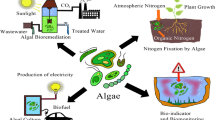Abstract
We investigated the potentially different effects of one of the most commonly used glyphosate formulations in Argentina, Glifosato Atanor®, and the technical-grade glyphosate on the pigment content, as biomass indicators of the algal fraction in a freshwater periphytic community. A laboratory bioassay was carried out in 250-ml beakers. Two treatments were used: technical-grade glyphosate acid and Glifosato Atanor® (isopropylamine salt of glyphosate 48 % w/v), which were at a concentration of 3 mg active ingredient per liter. Treatments and the control (without herbicide) were replicated in triplicate. The concentrations of chlorophyll a and b and carotenes were determined at 0, 2, 6, 10, 24, 48, 96 and 192 h after herbicide addition. A significant increase in pigment content was observed for both herbicides after a 2-day exposure. Moreover, the formulation had little or no effect compared to the active ingredient, suggesting that the additives of Glifosato Atanor® may not enhance glyphosate toxicity.

Similar content being viewed by others
References
Berkovic A, Marino D, Lespade P, Ronco A (2006) Análisis de pesticidas asociados al cultivo de soja en aguas y sedimentos de un sector productivo de la pampa ondulada. Anales XXVI Congreso Argentino de Química, San Luis, 8–053
CASAFE (2013) Mercado Argentino de Productos Fitosanitarios 2013. Cámara de Sanidad Agropecuaria y Fertilizantes, Buenos Aires
Forlani G, Pavan M, Gramek M, Kafarski P, Lipok J (2008) Biochemical bases for a widespread tolerance of cyanobacteria to the phosphonate herbicide glyphosate. Plant Cell Physiol 49:443–456
Giesy JP, Dobson S, Solomon KR (2000) Ecotoxicological risk assessment for Roundup® herbicide. Rev Contam Toxicol 167:35–120
Holtby LB, Baillie SJ (1989) Effects of the herbicide Roundup (glyphosate) on periphyton in Carnation Creek, British Columbia. In: Reynolds PE (ed) Proceedings of the Carnation Creek Herbicide Workshop, Forestry Canada, Canada, pp 224–231
Kirk JTO (1994) Light and photosynthesis in aquatic ecosystems. Cambridge University Press, Cambridge
Kish PA (2006) Evaluation of herbicide impact on periphyton community structure using the Matlock periphytometer. J Freshw Ecol 21:341–348
Lichtenthaler HK (1987) Chlorophyll and carotenoids: pigments of photosynthetic biomembranes. Methods Enzymol 148:349–382
Lipok J, Studnik H, Gruyaert S (2010) The toxicity of Roundup® 360 SL formulation and its main constituents: glyphosate and isopropylamine towards non-target water photoautotrophs. Ecotoxicol Environ Saf 73:1681–1688
Öncel I, Keleş Y, Üstün AS (2000) Interactive effects of temperature and heavy metal stress on the growth and some biochemical compounds in wheat seedlings. Environ Pollut 107:315–320
Pérez GL, Torremorell A, Mugni H, Rodríguez P, Vera MS, do Nascimento M, Allende L, Bustingorry J, Escaray R, Ferraro M, Izaguirre I, Pizarro H, Bonetto C, Morris DP, Zagarese H (2007) Effects of the herbicide Roundup on freshwater microbial communities: a mesocosm study. Ecol Appl 17:2310–2322
Peterson HG, Boutin C, Martin PA, Freemark KE, Ruecker NJ, Moody MJ (1994) Aquatic phytotoxicity of 23 pesticides applied at expected environmental concentrations. Aquat Toxicol 28:275–292
Pintilie M, Oprica L, Surleac M, Dragut Ivan C, Creanga DE, Artenie V (2006) Enzyme activity in plants treated with magnetic liquid. Rom J Phys 51:239–244
Powell HA, Kerby NW, Rowell P (1991) Natural tolerance of cyanobacteria to the herbicide glyphosate. New Phytol 119:421–426
Romero DM, Ríos de Molina MC, Juárez AB (2011) Oxidative stress induced by a commercial glyphosate formulation in a tolerant strain of Chlorella kessleri. Ecotoxicol Environ Saf 74:741–747
Sáenz ME, Di Marzio WD (2009) Ecotoxicidad del herbicida glifosato sobre cuatro algas clorófitas dulceacuícolas. Limnetica 28:149–158 (in Spanish)
Sáenz ME, Di Marzio WD, Alberdi JL, Tortorelli MC (1997) Effects of technical grade and a commercial formulation of glyphosate on algal population growth. Bull Environ Contam Toxicol 59:638–644
Samuel K, Bose S (1987) Bleaching of photosyntethic pigments in Chlorella protothecoides grown in the presence of SANDOZ 9785 (4-chloro-5-dimethylamino-2 phenyl-3 (2H) pyridazinone). J Biosci 12:399–404
Schönbrunn E, Eschenburg S, Shuttleworth WA, Schloss JV, Amrhein N, Evans JNS, Kabsch W (2001) Interaction of the herbicide glyphosate with its target enzyme 5-enolpyruvylshikimate 3-phosphate synthase in atomic detail. PNAS 98:1376–1380
Tsui MTK, Chu LM (2003) Aquatic toxicity of glyphosate-based formulations: comparison between different organisms and the effects of environmental factors. Chemosphere 52:1189–1197
Tukaj S, Tujaj Z (2010) Distinct chemical contaminants induce the synthesis of Hsp70 proteins in green microalgae Desmodesmus subspicatus: heat pretreatment increases cadmium resistance. J Therm Biol 35:239–244
Vera MS, Lagomarsino L, Sylvester M, Pérez G, Rodríguez P, Mugni H, Sinistro R, Ferraro M, Bonetto C, Zagarese H, Pizarro H (2010) New evidences of Roundup® (glyphosate formulation) impact on the periphyton and the water quality of freshwater ecosystems. Ecotoxicology 19:710–721
Vera MS, Di Fiori E, Lagomarsino L, Sinistro R, Escaray R, Iummato MM, Juárez A, Ríos de Molina MC, Tell G, Pizarro H (2012) Direct and indirect effects of the glyphosate formulation Glifosato Atanor® on freshwater microbial communities. Ecotoxicology 21:1805–1816
Zhu Y, Zhang F, Tong C, Liu W (1999) Determination of glyphosate by ion chromatography. J Chromatogr A 850:297–301
Acknowledgments
We thank Dr. Eugenia Di Fiori for field assistance and to the Associated Editor of the Journal for improving the manuscript. This work was supported by ANPCyT (PICT 2010-0908) and UBACyT O1/W550.
Author information
Authors and Affiliations
Corresponding author
Rights and permissions
About this article
Cite this article
Vera, M.S., Juárez, Á.B. & Pizarro, H.N. Comparative Effects of Technical-Grade and a Commercial Formulation of Glyphosate on the Pigment Content of Periphytic Algae. Bull Environ Contam Toxicol 93, 399–404 (2014). https://doi.org/10.1007/s00128-014-1355-x
Received:
Accepted:
Published:
Issue Date:
DOI: https://doi.org/10.1007/s00128-014-1355-x




